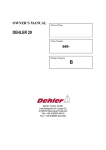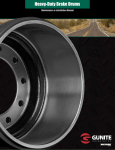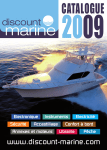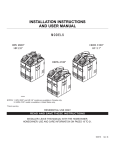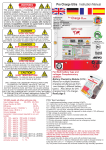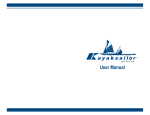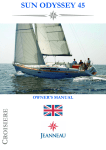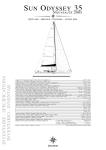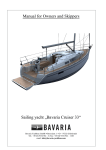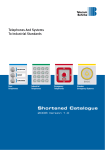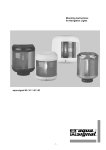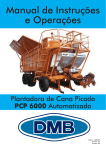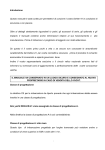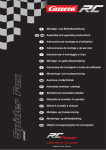Download a owner`s manual dehler 32
Transcript
OWNER’S MANUAL Name of Boat DEHLER 32 Order Number 740- Design Category A Dehler Yachts GmbH Industriegebiet Im Langel 22 D-59872 Meschede-Freienohl Tel.++49-(0)2903-440-0 Fax ++49-(0)2903-440-282 Yacht Manual DEHLER 32 Manual version 28.06.12 Your Distributor’s Stamp 2 - 68 Yacht Manual DEHLER 32 1.1 List of contents 1.1 LIST OF CONTENTS .............................................................................................................................. 3 1.2 LIST OF ILLUSTRATIONS ........................................................................................................................... 5 1.3 INTRODUCTION........................................................................................................................................ 6 1.4 STICK ON NOTICES - LIST ........................................................................................................................ 7 1.5 DESIGN CATEGORY ............................................................................................................................... 10 1.6 IDENTIFICATION .................................................................................................................................... 10 1.7 MANUFACTURER’S PLATE ..................................................................................................................... 11 1.8 STATEMENT OF CONFORMITY ................................................................................................................ 12 2. DESCRIPTION OF THE BOAT............................................................................................................. 14 2.1 MAIN DATA ........................................................................................................................................... 14 2.1.1 Load.............................................................................................................................................. 15 2.2 HEIGHT ................................................................................................................................................. 15 2.3 TRANSPORT MEASUREMENTS .................................................................................................................. 16 2.4 MAXIMUM NUMBER OF PERSONS ............................................................................................................ 16 2.5 LIFE-RAFT ............................................................................................................................................. 17 2.6 CRANES ................................................................................................................................................ 17 3. GENERAL DRAWINGS ......................................................................................................................... 18 3.1 CABIN VERSION .................................................................................................................................... 18 3.2 DECK PLAN ........................................................................................................................................... 19 3.2.1 Deck.............................................................................................................................................. 20 3.2.2 Guard rails.................................................................................................................................... 20 3.3 SAIL PLAN ............................................................................................................................................. 20 3.3.1 Sail dimensions.............................................................................................................................. 21 3.3.2 Rigging plan.................................................................................................................................. 21 3.3.3 Halyard running ............................................................................................................................ 22 3.3.4 Genoa slide / Main sheet traveller.................................................................................................. 23 3.4 SHROUDS, STAYS AND HALYARDS .......................................................................................................... 23 3.4.2 Forestay with Furlex-system .......................................................................................................... 24 3.5 CALCULATING THE LENGTH OF THE FORESTAY WIRE ............................................................................... 25 3.6 CALCULATING THE LENGTH OF THE LUFF EXTRUSION .............................................................................. 25 3.6 CALCULATING THE LENGTH OF THE LUFF EXTRUSION .............................................................................. 26 3.5 SUMMARY OF HALYARD SIZES ................................................................................................................ 27 4. DESCRIPTION OF INBOARD SYSTEMS............................................................................................ 28 4.1 ENGINE INSTALLATION .......................................................................................................................... 28 4.1.1 Exhaust system .............................................................................................................................. 28 4.1.2 Propeller ....................................................................................................................................... 29 4.1.3 Fuel tank ....................................................................................................................................... 30 4.1.4 Fuel supply/circulation .................................................................................................................. 30 4.1.5 Engine switch panel....................................................................................................................... 31 4.1.6 Engine monitoring ......................................................................................................................... 31 4.1 FRESH WATER, DRINKING WATER ........................................................................................................... 32 4.2.1 Cockpit shower .............................................................................................................................. 32 4.2.2 Hot water heater (Option).............................................................................................................. 33 4.3 WASTE WATER PUMP (SHOWER) ............................................................................................................ 33 4.4 ALTERNATING CURRENT INSTALLATION ................................................................................................. 34 4.4.1 Shore connection unit .................................................................................................................... 34 4.4.2 Battery charger Sterling................................................................................................................. 34 4.5 ONBOARD DIRECT CURRENT SYSTEM ...................................................................................................... 35 4.5.1 Master switches ............................................................................................................................. 35 4.5.2 Arrangement of main fuses............................................................................................................. 36 4.5.3 Identifying the cables ..................................................................................................................... 37 4.5.4 Additional fuses ............................................................................................................................. 37 4.5.5 Control panel data......................................................................................................................... 38 4.5.6 Battery Charging ........................................................................................................................... 38 4.5.7 Auxiliary supply............................................................................................................................. 39 4.5.8 Tank monitoring ............................................................................................................................ 39 3 - 68 Yacht Manual DEHLER 32 4.5.9 Terminals/Supplies .......................................................................................................................... 2 4.5.10 General consumers ...................................................................................................................... 40 4.5.11 Electric wiring diagram ............................................................................................................... 40 4.6 BILGE SYSTEMS ..................................................................................................................................... 41 4.6.1 Anchor locker ................................................................................................................................ 41 4.6.2 Drainage ....................................................................................................................................... 41 4.6.3 Hand bilge pump ........................................................................................................................... 41 4.6.4 Piston pump................................................................................................................................... 42 4.6.5 Electric bilge pump........................................................................................................................ 42 4.7 RUDDER SYSTEM .................................................................................................................................... 43 4.7.1 Tiller steering ................................................................................................................................. 43 4.7.2 Rudder blade and rudder bearing.................................................................................................... 43 4.8 GAS INSTALLATION ............................................................................................................................... 44 4.9 PUMP - WC............................................................................................................................................ 46 4.9.1 Rapid shut-off valves....................................................................................................................... 46 4.9.2 Holding tank.................................................................................................................................. 47 4.9.3 Holding tank indicator................................................................................................................... 47 4.9.4 Emptying of the tank ...................................................................................................................... 47 5. FIRE PROTECTION ............................................................................................................................... 49 5.1 5.2 5.3 5.4 5.5 5.6 FIRE PREVENTION ................................................................................................................................. 49 ACTIVE FIRE PROTECTION ...................................................................................................................... 50 FIREFIGHTING ....................................................................................................................................... 50 IN THE EVENT OF FIRE IN THE GALLEY .................................................................................................... 51 IN THE EVENT OF FIRE IN THE ENGINE COMPARTMENT ............................................................................. 51 IN THE EVENT OF FIRE IN THE LIVING AREA ............................................................................................. 51 6 HEATING ................................................................................................................................................. 52 6.1 HOT AIR ................................................................................................................................................ 52 6.2 DISPENSING PUMP/FILTER ...................................................................................................................... 53 6.3 TEMPERATURE CONTROL ....................................................................................................................... 53 7 . HULL OPENINGS, SEA COCKS........................................................................................................... 54 7.1 LEAK STOPPERS ..................................................................................................................................... 54 8. ANCHORING, TOWING AND MOORING SYSTEMS........................................................................ 55 8.1 8.2 8.3 8.4 ANCHOR ............................................................................................................................................... 55 SECOND ANCHOR................................................................................................................................... 55 MOORING ROPES ................................................................................................................................... 55 TOWING ROPE ....................................................................................................................................... 55 9. ENVIRONMENTAL PROTECTION ..................................................................................................... 57 9.1 9.2 9.3 9.4 9.5 9.6 9.7 9.8 FUEL AND OIL........................................................................................................................................ 57 RUBBISH ............................................................................................................................................... 57 NOISE ................................................................................................................................................... 57 BACKWASH ........................................................................................................................................... 57 EXHAUST FUMES ................................................................................................................................... 57 ANTIFOULING PAINT ............................................................................................................................. 58 PAINT REMOVER .................................................................................................................................... 58 HOLDING TANK ..................................................................................................................................... 58 10. TEN GOLDEN RULES FOR WATER SPORTS ENTHUSIASTS...................................................... 59 11. MAINTENANCE, REPAIRS AND CLEANING .................................................................................. 60 11.1 HULL, DECK ........................................................................................................................................ 60 11.2 CLEANING ........................................................................................................................................... 60 11.3 VENTILATION ...................................................................................................................................... 60 11.4 RIGGING ............................................................................................................................................. 60 11.5 CARE OF THE SAILS ............................................................................................................................. 61 11.5 ENGINE AND PROPELLER ...................................................................................................................... 62 11.6.1 Interval between engine servicing................................................................................................. 62 4 - 68 Yacht Manual DEHLER 32 11.6.2 Exhaust system /Maintenance....................................................................................................... 62 11.7 ELECTRICITY ....................................................................................................................................... 62 11.8 HOSE CLAMPS ..................................................................................................................................... 63 11.9 HEAT EXCHANGER ............................................................................................................................... 64 11.10 PUMP WC ......................................................................................................................................... 64 11.11 HOLDING TANK ................................................................................................................................. 64 11.12 PAINT................................................................................................................................................ 64 11.13 WORN AND SPARE PARTS ................................................................................................................... 65 11.14 HULL OPENINGS................................................................................................................................. 65 11.15 REPAIRS ............................................................................................................................................ 65 12. WINTER STORAGE............................................................................................................................. 65 13. FINAL REMARKS AND TIPS ............................................................................................................. 65 14. WARRANTY ......................................................................................................................................... 67 15. MANUFACTURERS’ INFORMATION............................................................................................... 67 1.2 List of Illustrations FIGURE 1: WARNINGS .................................................................................................................................. 9 FIGURE 2: TRANSPORT MEASUREMENTS ..................................................................................................... 16 FIGURE 3: LIFTING POINTS FOR BELTS ......................................................................................................... 17 FIGURE 4: GENERAL .................................................................................................................................. 18 FIGURE 5: DECK PLAN ................................................................................................................................ 19 FIGURE 6: SAIL PLAN ................................................................................................................................. 21 FIGURE 7: HALYARD RUNNING ................................................................................................................... 22 FIGURE 8: SHROUDS STAYS ........................................................................................................................ 23 FIGURE 9: FORESTAY WITH FURLEX ........................................................................................................... 24 FIGURE 10: ENGINE INSTALLATION ............................................................................................................. 29 FIGURE 11: FUEL TANK .............................................................................................................................. 30 FIGURE 12: FUEL LINES .............................................................................................................................. 31 FIGURE 13: DRINKING WATER .................................................................................................................... 32 FIGURE 14: SHORE CONNECTION PANEL ...................................................................................................... 34 FIGURE 15: MASTER SWITCHES .................................................................................................................. 35 FIGURE 16: MAIN FUSES............................................................................................................................. 36 FIGURE 17: CONTROL PANEL WITH CONNECTION NUMBERS ......................................................................... 37 FIGURE 18: TERMINALS ............................................................................................................................... 2 FIGURE 19: BILGE SYSTEM ......................................................................................................................... 41 FIGURE 20: TILLER STEERING ..................................................................................................................... 43 FIGURE 21: GAS INSTALLATION .................................................................................................................. 44 FIGURE 22: GAS SHUT-OFF VALVE .............................................................................................................. 45 FIGURE 23: RAPID SHUT OFF VALVE SHOWER ROMM .................................................................................... 46 FIGURE 24: HOLDING TANK SYSTEM ........................................................................................................... 47 FIGURE 25: FIRE EXTINGUISHERS................................................................................................................ 50 FIGURE 25: HOT AIR .................................................................................................................................. 52 FIGURE 26: HULL OPENINGS ....................................................................................................................... 54 5 - 68 Yacht Manual DEHLER 32 1.3 Introduction This manual has been written and compiled to make it possible for you to use your sailing yacht, a DEHLER 32, in a safe and pleasant way. Apart from many details regarding the yacht itself, the manual also contains details about the equipment supplied or integrated fittings and information on its use and maintenance, in addition to the information given by the manufacturer. Please read the manual through carefully and get familiar with everything before you go sailing with your yacht. We recommend that you make copies of the important parts of the manual and of some of the manufacturer’s information, such as instructions about maintenance and warnings, so as to have them handy on board in case you need to find out the cause of a technical fault quickly and remedy it. We hope you will enjoy your new DEHLER 32 and wish you good luck and safe sailing. An owner’s manual however can never replace the knowledge of seamanship which is necessary. An Owner’s Manual is a technical document which gives you a general description of the yacht and its technical systems. It helps the skipper/sailor to handle and maintain the yacht and its systems safely, identify possible technical faults and sometimes even to rectify these faults himself. Furthermore it is to the advantage of the owner to undertake maintenance and servicing of the Dehler 32 and thus maintain its value. Maintenance should only be done by experienced people. Changes which are done after delivery of the boat without any notice and confirmation by the yard are out of responsibility of the yard. The shipyard reserves the right to carry out changes in equipment and technique. The systems represented in this manual should not be considered as a basis for the sales contract. In this respect you should use the construction specifications and the relevant price list for the purchase of your yacht. PLEASE KEEP THIS MANUAL IN A SAFE PLACE AND GIVE IT TO THE NEW OWNER, IF YOU SELL THE YACHT. 6 - 68 Yacht Manual DEHLER 32 This owner’s manual is not a course on boating safety or seamanship. If this is your first craft, or if you are changing to a type of craft you are not familiar with, for your own comfort and safety, please ensure that you obtain handling an operating experience before “assuming command” of the craft. Your dealer or national sailing federation or yacht club will advise you of local sea schools, or competent instructors. Ensure that the anticipated wind and sea conditions will correspond to the design category of your craft, and that you and your crew are able to handle the craft in these conditions. Even when your boat is categorized for them, the sea and wind conditions corresponding to the design categories A, B and C range from severe storm conditions for category A, to strong conditions for the top of the category C, open to the hazards of a freak wave or gust. These are therefore dangerous conditions, where only a competent, fit and trained crew using a well maintained craft can satisfactorily operate. This owner’s manual is not a detailed maintenance or trouble-shooting guide. In the case of difficulty, refer to the boat builder or his representative. If a maintenance manual is provided, use it for the craft’s maintenance. 1.4 Stick on notices - List List of the most important information, indicated by stick on notices. Observance of the notices is very important for both the boat and its crew. Non-observance of the notices can lead to total loss of the boat and problems for the crew. As the skipper you are responsible for the boat’s safety and you should inform new crew members about the notices and their meaning. Don’t use the cooker for heating! Notice on front trim of the cooker lid Shut off valve Gas Oven Notice on the locker flap in the stern cabin port side Main switch Engine Notice next to the switch saloon sofa, in front of gally Main switch General consumption Notice next to the switch u-sofa salon Emergency shut-off valve Fuel Diesel engine Only switch with neutral number of revolutions! 7 - 68 Sticker base of wetcell locker Sticker next to the Gas/Switch Yacht Manual DEHLER 32 Cold-resistant Please observe manufacturer’s instructions! Switch at navi place for boiler and head below cover WC Fuse 12V A= see print Sticker in space U-sofa port side Automatic fuse 110V or 230V Sticker next to the automatic fuse Shore connection in cockpitlocker star bord Sticker Notice for fire extinguisher under navigation Fire extinguisher seat and under the aft locker starboard Sticker switch pump shower Sticker in front of head When sailing, close Sticker on bulkhead head to cockpit locker, the sea cocks door in front of head, galley door below sinks Notice for the escape hatch Sticker on frame of escape hatch forward Lifting belt position Four stickers on deck side Gas Installation Warnings Door in front of gasbox Notice for operating pressure of gazsystem Sticker in gazbox 8 - 68 Yacht Manual DEHLER 32 Notice for Closing hatch on turn Sticker in aftcabin by cockpit hatch Notice for opening for fire extinguisher Sticker on stairs Notice for deck extraction holding tank Sticker on deck by extractions cap Notice for crushing hazard Sticker in cockpit, above the Display Autopilot FIGURE 1: WARNINGS 9 - 68 Yacht Manual DEHLER 32 1.5 Design Category One of the requirements of the EC Directive on Pleasure Craft is that every boat must belong to a specific design category. The yacht type DEHLER 32 belongs to Design Category A. The Directive describes Design Category A as follows: Design Category A: High Sea Designed for longer trips, with possible weather conditions of a force 8 wind or above (Beaufort Scale) and waves 1) as high as 4 m or more, these boats can continue sailing on their own. Abnormal conditions such as hurricanes are excluded. Such conditions may be encountered on extended voyages, for example across oceans, or inshore when unsheltered from the wind and wave for several hundred nautical miles. 1.6 Identification For a yacht of this size the EC Directive only provides for B module certification. This means that the manufacturer certifies the conformity of its construction and equipment with the directive, but that its stability needs to be tested by a recognised testing institute. The International Marine Certification Institute, one of the testing institutes authorised by the EC Directive, was in charge of testing; see the Statement of Conformity on page 12. The hull identification number was stamped in the gel coat on the surface of the starboard side of the boat. This is a worldwide unique succession of numbers and letters. For example: DE-DEH 74011K909 This succession of numbers and letters comprises the following data: DE DEH 74 11 K 9 09 Month January February March April Germany, Country of Origin Unique Shipyard Code (the Register is kept by the German Boat and Shipbuilders’ Association) Designated Type as chosen by the shipyard Serial Construction Number Start of Construction Month November 2009, when construction started End digits of the year 2010, when the yacht was delivered Code A B C D Month May June July August Code E F G H 10 - 68 Month September October November December Code I J K L Yacht Manual DEHLER 32 1.7 Manufacturer’s Plate The manufacturer’s plate on the companionway bulkhead starboard is a requirement of the EC Directive, giving certain data which are explained here. Standard keel Shallow keel Explanation of the information required by the Directive: A Design Category A: High Sea Maximum Load (as ISO 14946) This weight indication includes persons, supplies, food supplies, water, fuel and personal equipment (see chapter 2.1.2.) Max. no of Persons (6, in this case) Maximum number of persons, recommended by the manufacturer, when the boat is located in a maritime area corresponding to its design category. (see chapter 2.4) For shallow draft keel the maximum number of Persons is 5, when the boat is located in a maritime area corresponding to design category A. 11 - 68 Yacht Manual DEHLER 32 1.8 Statement of Conformity Declaration of conformity for sports boats regarding design and construction as well as noise emission of sport boats according to guideline 94/25/EG revised by guideline 2003/44/EG (to be filled out by the craft manufacturer) Name of the craft manufacturer: Street: Im Langel 22 City: Meschede Dehler Yachts GmbH postal code: Country (Abb.): 59872 Germany Name of the notified body for design and construction (if applicable) Name: Internaltional Marine Certification Institute Street: Rue Abbé Cuypers 3 City: Brüssel Postal Code: 1040 Country (Abb.): BE ID No.: 0609 EC-Type Examination Certificate Number: BDEH002 medium keel Date: 16/06/2010 EC-Type Examination Certificate Number: BDEH001 shallow keel Date: 16/06/2010 EC-Type Examination Certificate Number: BDEH003 deep keel Date: 16/06/2010 as far as evaluation is done according to ESR3.2 and 3.3: Date: (Year/Month/Day) Name of the notified body for noise emission (if applicable) Name: City: Street: Postal Code: Country: ID No.: Module(s) used for design and construction: A * Aa * B+C T Module used for noise emission: A T Aa * G * H * Other used directives: DESCRIPTION OF THE CRAFT Craft identification number (CIN) Model description : Type of craft Sailing boat T * * * other (describe): Multihull Steel, alloys Diesel engine * B+F * G* H* Wood other (describe): Type of machine * Outboard engine others (describe): T Width WH: 3,25 m Electric engine T Inboard engine Gas engine Z-drive without integrated exhaust system Z-drive with integrated exhaust system others (describe): closed * open * others (describe): * C * D * B Maximum recommendation: Installe_ T A * * Rudder/Oars Deck T Plastic, FRP Design category(n): Engine performance Length of hull LH: 9,80 m Type of main propulsion T Sail * * * others (describe): Building material: Aluminium, alloys * * * Motor boat * * * * * Type or number : 32 inflatable, dinghy Type of craft hull T Monohull B+E D E - D E H 7 4 Dehler * B+D * Draught D: * partially closed 21 kW 15,5 kW (if applicable) 1,74 m / 1,43 m / 1,98 m This declaration of conformity is issued on the exclusive responsibility of the manufacturer. I hereby declare and affirm for the manufacturer or the proxy that the above designated craft meets the herein and overleaf listed requirements and correspond with the model for which an EC-Type Examination Certificate Number has been provided ( delete the last part if an EC-Type Examination Certificate Number has not been provided). Name and position: Volker Kodalle Signature and title: (Person, that signs for the manufacturer or the proxy) (or respective symbol) Date and location: (Year/Month/Day) Freienohl, 12 - 68 Yacht Manual DEHLER 32 13 - 68 Yacht Manual DEHLER 32 2. Description of the boat 2.1 Main data Length overall Length waterline Maximum beam Beam hull Draught hull Max. draught standard keel Max. draught shallow keel Max. draught racing keel Side height midships Transport height standard keel without support Full height mast* Full height mast with additional antennas Lol Lwl Bmax Bh Dhull Dmax Dmax Dmax Db HT HD Hmax D 9.80 m 8.94 m 3.25 m 3.25 m 0.40 m 1.74 m 1.35m 1.98 m 1.17 m 3.74 m 15.55 m Mainsail 33.7 m², foresail of 15.6 to 88.7 m² (max. Sailareas) Unladen weight standard keel Unladen weight shallow keel Unladen weight racing keel Uw Uw Uw 4310 kg 4530 kg 4215 kg Max. weight standard keel Keel weight standard keel 174 cm Vmax Gs 5390 kg approx. 1500 kg Total maximum load (see chapter 2.1.1) 1108kg VOLVO inboard diesel engine, type Optional: VOLVO inboard diesel engine, type D1-20 13,3 kW/ 18 PS D1-30 20,1 kW/ 27,3 PS 230 V - Alternating current Landline installation with battery charger and a 230 V socket 12 V – Direct current installation Batteries Starter battery · General use batteries · Or Batteries 12 V 70 Ah 1 x 12 V 95 Ah AGM 2 x 12 V 95 Ah AGM Tanks 1 PE fresh water tank 1 stainless steel fuel tank 1 PEl WC holding tank 100 l 65 l 35 l 14 - 68 Yacht Manual DEHLER 32 2.1.1 Load IMPORTANT When loading the craft, never exceed the maximum recommended load. Always load the craft carefully and distribute loads appropriately to maintain design trim (approximately level). Avoid placing heavy weight high up. Numbers of persons: 6 Persons (5 Persons/Shallow keel) Basic equipment Stores and cargo Consumable liquids, portable tanks Liferaft Maximum load (according manufacturers plate) 450 kg (375 kg) 100 kg 270 kg 10 kg 40 kg + _________ 870 kg (795 kg) Capacity of fixed tanks Diesel (110 ltr) Water (100 ltr) Total maximum load 110 100 kg kg + __________ 1080 kg IMPORTANT Always store personal equipment and portable parts in a position where they are unable to move in case of high waves or heeling of the boat. 2.2 Height · The full height can be critical when you have to pass under a bridge or a high voltage line. It is the height above the waterline up to the highest point of the mast. It is measured without possible antennas or radar reflectors but does include the measurement for the WINDEX. Please correct the measurement if you install any additional gear and mark it in the last line of the main data. 15 - 68 Yacht Manual DEHLER 32 FIGURE 2: TRANSPORT MEASUREMENTS 2.3 Transport measurements Standard keel draught 1.74 m: A = Transport height without stand, pulpit and helm 3,74 m B = Transport height with stand and pulpit 4,04 m 2.4 Maximum number of persons The Directive requires a maximum number of persons on board as a defined recommendation when the boat is sailing in the conditions it is intended for. The Dehler 32 is designed for offshore navigation, that is to say trips of several days between different ports. Therefore we recommend the following: · For sailing trips lasting several days, no more than 6 persons should be on board, since this is the maximum number of berths available; For shallow draft keel version 5 Persons · Note: There must be enough life-jackets on board for all persons on the boat. An inflatable life-raft should have enough space for at least 6 persons. For day trips, if possible not more than 8 persons should be on board, since there is only enough space for this number in the cockpit. For very short trips, the number can be increased. · Note: There must be enough life-jackets on board for all persons on the boat. IMPORTANT Do not exceed the maximum recommended number of persons. Regardless of the number of persons on board, the total weight of persons and equipment must never exceed the maximum recommended load. Always use the seats /seating spaces provided. Tief Kiel Medium Kiel Kurzkiel STIX 34,2 34,3 33,6 Deep keel Medium draft keel Shallow draft 16 - 68 Angle of vanish stability 137° 136° 135° Yacht Manual DEHLER 32 2.5 Life-raft A life-raft corresponding to the sailing area designated by the design category must be mounted in the place provided on deck. The life-raft must have enough room for all people on board. NOTE According to the keel version, a 6 or 5 man life-raft must be stowed on deck 2.6 Cranes In many harbours yachts are taken on land with a crane and hoisting gear. Belts have to be placed taking into account the solidity of the boat’s build and the distribution of weight. On the Dehler 32, the recommended lifting points are marked on the edge of the coaming. The forward lifting point corresponds to A, approx. 3.75 m from the front of the bow and the after lifting point to B, approx. 1.80 m from the edge of the stern. The distance C between these two marks is about 4.70 m. With reference to these markings, the belts should not be displaced more than as follows: Rear and front: max. 200 mm forwards or backwards. FIGURE 3: LIFTING POINTS FOR BELTS 17 - 68 Yacht Manual DEHLER 32 3. General Drawings 3.1 Cabin Version 1. Anchor peak 2. Bow berths 3. Water tank 4 Bow locker 5.Battery: general Consumption 6 Battery Starter engine 7 Saloon Sofa 8 Galley 9. Gas cooker 10.- Navigation area 11 Battery changer 12 engine 13 Heat exchanger (option) 14 aft cabin 15 head 16 wastewater tank 17 Fuel tank 18 heating (option) FIGURE 4: GENERAL 18 - 68 Yacht Manual DEHLER 32 3.2 Deck plan Components 1. below deck Furler 2. Anchor roller 3 Pulpit 4. Deck hatch (escape-hatch) 5 Filler nozzle water 6. Mast collar 7. Shroud chain plate 8. Deck hatch saloon 9. Genua track 10. Spring cleats (option) 11. Entrance hatch 12. Halyard winches 13. Genua winches 14. Exhaustion wast water 15. Filler nozzle diesel 16. Cockpit locker (Locker for life raft storage) 17. Rudderbearing top 18. Main Sheet winches (option) Geman Main Sheet 19. Traveller (option) 20. Exhaust heating (option) FIGURE 5: DECK PLAN 19 - 68 Yacht Manual DEHLER 32 3.2.1 Deck The deck is a sandwich construction. Balsa wood of different thicknesses is used as intermediate layer. In areas with a lot of strength reinforcements of aluminium, plywood or solid wood are used. Fittings such as genoa slides, halyard pegs, winches, deck hatches or rollers are screwed and sealed with a flexible silicone rubber substance. Attention There must be a 6 person liferaft stored on deck IMPORTANT Please keep portlights, windows, washboards, doors, hatches or ventilation openings closed when appropriate, e.g. in rough weather or at planing speeds. If necessary, provide operating instructions. 3.2.2 Guard rails The deck is equipped with a pulpit, a pushpit, an integrated safety ladder/swimming ladder and guard rail supports. The deck guard rail has a continuous height of 610 mm. The eight railing posts and the bolts for the pulpit and pushpit are screwed on the aluminium deck reinforcement and glued with epoxy resin. 3.3 Sail plan Mainsail Jib 107 % Spinnaker approx. Gennaker 33.7 m2 26.3 m2 88.7 m² 74.2 m² The canvas quality is chosen for the wind strain corresponding to the sails. The mainsail can be reduced by two one-line quick reefings, at 1.51 m above the main boom (reefing 1) and at 3.27 m above the boom (reefing 2). 20 - 68 Yacht Manual DEHLER 32 3.3.1 Sail dimensions · · · · P = 12.67 E = 4.45 I = 13.18 J = 3.60 With these data any sailmaker can make the sail you require. FIGURE 6: SAIL PLAN 3.3.2 Rigging plan · The mast is placed in a mast rail under the deck: · Mast length 15.77 m · Boom length 4.61 m Section profile: Mast Selden C175/93, Boom 135/71 Boom is fitted with Selden automatic reefing system for reef 1 and reef 2. By this you are able to reef sail by only one line. 21 - 68 Yacht Manual DEHLER 32 3.3.3 Halyard running FIGURE 7: HALYARD RUNNING 6. Main boom kicking strap 7. Outhaul 8. Reef 9. Main halyard 10. Spinnaker halyard 1. Spi boom Lift 2. Furlex 3. Gennaker tacking linie 4. Genua 5. Reef 22 - 68 Yacht Manual DEHLER 32 3.3.4 Genoa slide / Main sheet traveller Genoa slide and main sheet traveller are adjusted progressively from the cockpit. The adjustable top setting of the genoa slide is particularly sensible with a foresail roller reefing system. 3.4 Shrouds, stays and halyards Dyform rig Dimensions Forestay Type Dyform 7mm Ø 13515 mm Backstay Type Dyform 6mm Ø 11810 mm D2 Type Dyform 46mm Ø 3990 mm V2/D3 Type Dyform 6mm Ø 7725 mm D1 Type Dyform 6mm Ø 5270 mm V1 Type Dyform 6mm Ø 5175 mm FIGURE 8: SHROUDS STAYS 23 - 68 Yacht Manual DEHLER 32 3.4.2 Forestay with Furlex-system FIGURE 9: FORESTAY WITH FURLEX 24 - 68 Yacht Manual DEHLER 32 3.5 Calculating the length of the forestay wire Here is a copy of table Dehler-32 from the furlex manual. 25 - 68 Yacht Manual DEHLER 32 3.6 Calculating the length of the luff extrusion 26 - 68 Yacht Manual DEHLER 32 3.5 Summary of halyard sizes Name Material Diameter Length HMPE 8 mm 30 m Identifying thread blue Genoa halyard 1st Spinnaker halyard Liros-Herkules 10 mm 37 m red Main halyard HMPE 8 mm 32 m white Main sheet Liros-Herkules 10 mm 36 m white Boom kicking strap PET 10 mm 12 m white Boom kicking strap by option Racepaket Liros-Herklues 8 mm 8m black Reefing 1 PET 8 mm 24,4 m blue Reefing 2 PET 8 mm 32,4 m red Genoa sheet Liros-Herkules 12 mm 12 m blue Flag halyard PET 4 mm 14 m white Mainsheet traveller line Genoa travellerline Liros-TopCurising Liros-Dynamic 8 mm 7m white 6 mm 13 m blue Backstay below PET 8 mm 16 m white Backstay top part1 HMPE 6 mm 4m gray Backstay top part 2 HMPE 5 mm 3,8 m gray Backstay top part 3 HMPE 4 mm 3,6 m gray Spinnaker Aftguys Liros-Dynamic 10 mm 22 m green Spinnaker downhaul Liros-Top 8 mm 24 m yellow Service line Spinnaker slides Spinnaker sheets Liros-Herkules 8 mm 28 m yellow Liros-Herkules 10 mm 22 m red Genakersheet Liros-Herkules 10 mm 22 m red Fock Inhauler Liros-Herkules 8 mm 8m 5/3 white KF blue 27 - 68 Yacht Manual DEHLER 32 4. Description of inboard systems 4.1 Engine installation The Dehler 32 is equipped with a Volvo engine installation and Saildrive. The table shows you the most important data. At the same time we would like to refer you to the extensive information provided by Volvo. As skipper, you must be familiar with the safety and maintenance indications. Manufacturer Type Number of cylinders Cylinder capacity Rated power rpm Cooling Volvo Volvo D1-20 D1-30 3 3 3 760 cm 1130 cm3 13,3 kW / 18 PS 20,1 kW / 27,3PS 3.200 U/min 3.200 U/min Fresh water cooling with Fresh water cooling with heat exchanger heat exchanger Reduction ratio 2,19: 1 2,19: 1 Saildrive gearbox 130S 130S Dry weight ca. 144kg ca. 158 kg Three phase current generator 14 V 115A 14 V 115 A Folding screw 16 x 12" 16 x 13" According to the manufacturer there may be slight differences in pitch and diameter As regards the installation the engine compartment is insulated on partition bulkheads. The engine is accessible if you remove the stairs of companionway. In addition you can open a flap hatch in the shower room and in the rear cabin to get access to all the important components of the engine. Oil dipstick is able to be controlled through maintenance hatch in portside stern cabine. 4.1.1 Exhaust system The yacht is equipped with a wet exhaust system, i.e. cooling seawater is injected into the exhaust outlet pipe, which cools the exhaust fumes. This mixture is taken downwards to a silencer/water collector – mounted under the double berth. The pipe continues on towards the stern and forms a swan’s neck in front of the starboard inner edge of the transom. The exhaust pipe is made of synthetic rubber reinforced with a steel spiral. The pipe is heatresistant, although with certain limits. Do not interrupt the sea water supply. Attention must be paid therefore to provide a continuous supply. The pipe is fixed at all connection points with two clamps. 28 - 68 Yacht Manual DEHLER 32 FIGURE 10: ENGINE INSTALLATION Components 1 = Inboard diesel 4 = Folding propeller 7 = Exhaust pipe 2 = Saildrive 5 = Gasket 8 = Swan’s neck 3 = Zinc ring 6 = Water collector 9 = Outlet IMPORTANT Before you start the engine, take care, that the cooling water valve is open. Every time after starting the engine, you should check that cooling water is being expelled with the exhaust fumes at the outlet! 4.1.2 Propeller The yacht can be fitted with either a fixed propeller or a folding propeller. IMPORTANT In freshwater areas the zinc ring (3) must be replaced by a magnesium ring. 29 - 68 Yacht Manual DEHLER 32 4.1.3 Fuel tank A 65 l stainless steel-diesel tank is installed under the beth in stern cabin port side. It is filled through the filler nozzle on the main deck towards the front starboard side of the cabin roof structure (marked FUEL with symbol). Supply of and return to the inboard diesel engine occurs through fireproof fuel hoses in accordance with ISO 7840. Outboard ventilation of the fuel tank is carried out via a swan`s neck in the locker to the port side deck and exits at the port side edge. FIGURE 11: FUEL TANK 4.1.4 Fuel supply/circulation The feed pipe has been mislaid from the inlet pipe on the fuel tank, via a quick shut off valve on the fuel pipe to the fuel filter/water separator under the bunk in the stern cabin and on to the fine filter and diesel pump. The engine return pipe to the tank is situated almost parallel. A quick shut off valve is installed on the feed pipe. This can be reached through the aft locker in the head. IMPORTANT Perfect running of the engine is only possible with clean fuel. Therefore it is absolutely essential to regularly inspect and clean the filter and water separator. Warning Turn off the engine, heating and the cooker when filling the tank. Never smoke while filling the tank! Never approach with a naked flame! WARNING To ensure that the fuel system does not draw in any air regularly check the fuel level on the E-Panel in the navigation area! 20% fuel reserve should be kept, as all of its capacity may not be usable according to trim and loading. 30 - 68 Yacht Manual DEHLER 32 Components 1. Return pipe 2. Feed pipe 3. Filter and pump 4. ventilation tube 5. Fuel tank 6. Filling cap FIGURE 12: FUEL LINES 4.1.5 Engine switch panel The engine switchboard with a control lever is installed in the cockpit’s coaming starboard. All other information can be found in the extensive information provided by Volvo. 4.1.6 Engine monitoring It is especially important to heed the engine temperature light in calm and tidal waters. If the water supply is disturbed engine over-heating may rapidly occur. As the light does not fall in the field of view of the skipper an audible warning signal should reliably prevent such a situation. See also the instructions in the Volvo manual. FIGURE.: FUEL PIPE SYSTEM NOTE The single lever circuit is a combination between a circuit and a throttle. Always allow a few seconds in neutral between gear changes, to take care of the gear. NOTE Please avoid contact of flammable material with hot engine parts. Please prevent damage of fuel lines. 31 - 68 Yacht Manual DEHLER 32 4.1 Fresh water, drinking water The Dehler 32 has a polyurethane water tank, with a capacity of 100 l. It is installed under berth in fore cabin. The filler nozzle is on the portside on the coaming. An electric pressure water pump with a secondary surge tank supplies the sink and the washbasin in the toilet area. A heat exchanger with a 22 l capacity is installed for the production of hot water. It is situated in the starboard rear storage space (Option) 4.2.1 Cockpit shower The fresh water tank also supplies the cockpit shower. The unit is installed on the cockpit starboard. Components 1. Ventilation tank 2. Water tank. 3. Pressure water pump 4. Filler nozzle 5. Hand washbasin outlet 6. hot water supply 7. cold water pipe 8. Outlet head 9. heat exchanger 10. Cocpit shower FIGURE 13: DRINKING WATER 32 - 68 Yacht Manual DEHLER 32 4.2.2 Hot water heater (Option) If the boat is fitted with a hot water boiler the system is supplied via the shower installation with a tap in the hand washbasin, from which water can be drawn. In addition a drainage pumpe for the showers tray is supplied. The engine twin-circuit cooling is used amongst other things as heat source. Since it is anticipated that the engine would be used only in calm weather and for manoeuvring in harbour, the hot water boiler/heat exchanger is additionally equipped with a 1200 Watt electric heating cartridge, which in harbours can be used with 230 V alternating current via the shore connection. You will find the switch in the space under the navigation table. The cold water goes to the insulated boiler by means of the pressure pump. . The water in the water boiler is heated by the hot water of the engine. The washbasin, galley and eventually the cockpit shower are thus supplied. The surge tank in the cold-water circuit responds also to the withdrawal of hot water. 4.3 Waste water pump (Shower) We have installed a shower water suction pump in the locker space under the hand washbasin. At 12 l/min. the pump removes more water than can be provided by the water supply. If the water in the shower tray rises, this means that the filter is clogged and should be cleaned. It can be easily reached in the locker space under the washbasin. The stopcock can be found at the side of the washbasin 33 - 68 Yacht Manual DEHLER 32 4.4 Alternating current installation If the yacht is equipped with a 230 V shore connection unit, when you are mooring in a harbour, you can feed power into the onboard system with a shore power cable. The socket is found at the end of the cockpit. There is a 230 V socket in the shore connection unit in the space under the navigation table. 4.4.1 Shore connection unit · · · · · · On/off switch, battery charger FI- protection switch System control light On/off switch, heat exchanger with control light 230 V safety socket Charging of the battery starts once the shore connection cable is plugged in. The 230 V socket is likewise ready to function. It is exclusively for electrical use. Please think about the power limit of land sockets. The feed for hot water heating in the heat exchanger has fixed cabling, which is separately switched and protected. FIGURE 14: SHORE CONNECTION PANEL 4.4.2 Battery charger Sterling Name Model Voltage Power Charging voltage Charging characteristic Standard PCU1230 230/110V 30 Amp. 14,35-13,35V IUoUo NOTE Please make yourself familiar with the safety instructions attached for the battery charger! 34 - 68 Yacht Manual DEHLER 32 4.5 Onboard direct current system The 12 V direct current system is responsible for the power supply for all general use appliances. The 12 V – Plus load circuit can be switched off using the main switches next to the port companion way and with the second master switch of the starter battery. The 12 V power supply is comprised of the following main components/power supply sources. Starter battery, consumer battery, motor generator (dynamo), and a battery charger 4.5.1 Master switches The master switch of engine is mounted in aft cabin portside. The masterswitch of consumer batterie is mounted portside saloon sofa. 1 2 FIGURE 15: MASTER SWITCHES 1 = Master switch of engine in aft cabin 2 = Master switch of consumer in saloon 35 - 68 Yacht Manual DEHLER 32 4.5.2 Arrangement of main fuses The following main fuses are to be found under the saloon sofa port side behind the batteries – depending on the equipment: 3 2 4 1 FIGURE 16: MAIN FUSES 1= prefuse consumer 125A 3= Fuse charging current 2= General consumption 100A 4= steady plus Further distribution to the “general consumption” is via the power circuit distributor, (switch board) above the starboard chart table. 1 36 - 68 Yacht Manual DEHLER 32 FIGURE 17: CONTROL PANEL WITH CONNECTION NUMBERS 4.5.3 Identifying the cables The following numbers are to be found on the electric cables. Thus it is possible to check the clamped connections and leads easily. 5 = Instrument lighting 7 = Interior lighting starboard 10 = Self steering gear 12= Bilge pump 14 = 12 V socket 6 = Interior lighting port 9 = Pressure water pump 11 =Refrigerator 13 = Waste water pump Navigation lights are fuses with dip switches 4.5.4 Additional fuses Apart from the fuses on the control panel and in the companion way, three more “in-line” fine wire fuses have been installed, in each case a 2 A fine fuse in the control cables of the indicator for the consumer batteries. An additional “delay action” 5 A fine wire fuse protects the cable for the engine compartment ventilation. 37 - 68 Yacht Manual DEHLER 32 4.5.5 Control panel data Manufactured by Philippi Circuits with thermal protected switches Combined indicator voltmeter for water/diesel + holding tank (optional) indicators 12 V socket Direct current consumers The main circuits are the following: Navigation lights Water pumps VHF Radio/ radio Auxiliary consumption Anchor winch Refrigeration unit for cool-box Engine instruments/Tank indicator Electronic navigation instruments Bilge pumps, Shower/Bilge Self steering gear 4.5.6 Battery Charging The yacht is equipped with a 12 V 75 Ah starter battery, placed under portside saloon sofa. Depending on the equipment, the installed consumer batteries are 1 x 95 Ah AGM or optionally 2 x 95 Ah AGM, installed under the port side salon berths. Both batteries are maintenance-free and protected against leakage. REMEMBER Batteries can only be replaced by AGM or Gel Batteries The batteries are charged via the engine alternator. As soon as the shore connection is switched on, the battery charger starts charging all batteries. Alternating current consumers The fixed 230 V connections are for the battery charger and hot water provision. The 230 V sockets in the panel of the land line unit are intended for carrying out small repairs with electrical machines when you are on a sailing trip or for connecting other comfort consumers. REMEMBER The power of shore connections is usually limited. Max. 600 – 800 Watt. 38 - 68 Yacht Manual DEHLER 32 4.5.7 Auxiliary supply Navigation lighting must have absolute priority. If there is a drop in capacity caused by a technical fault in the supply, all other consumers must first be switched off. Running the engine, even when sailing, can recharge the batteries, which enables you to switch on the second most important consumers . 4.5.8 Tank monitoring The fuel tank, water tank and holding tank indicators are all integrated in the navigation control panel. Thus their level can be checked. NOTE The control indicator is a stepped indicator with percental steps from 0 till 100% 39 - 68 Yacht Manual DEHLER 32 4.5.9 Terminals/Supplies In the event of a fault it is necessary for its elimination to check whether the distribution points are receiving any current. In this page we want to show you where the terminals and supplies are positioned and how to find them on your boat. 1x6 for Mast under saloon sofa starboard on main bulkhead Distributor N° 1 1x6 under saloon cushion port side on port side galley Distributor N°2 Distributor Nº 3 supply is on the side in front off the chainplate support starboard FIGURE 18: TERMINALS 39 - 68 Yacht Manual DEHLER 32 4.5.10 General consumers This particularly includes the interior lighting with sockets. All lights have an integral switch so that it is possible to use the electricity only where required. 4.5.11 Electric wiring diagram The wiring diagram helps the specialist when looking for faults. It shows in a diagram the layout of the 12 V and 230 V system. Important Incorrect exposure to the electrical installation can cause severe injury and burns. Important Before setting out: check the battery voltage and functioning of the navigation lights Important Never work on live electrical installations, choose more or less powerful fuses and thermofuses, install electrical appliances that exceed the permissable loading of the power circuit. Important information concerning the alternating current installation: WARNING In order to avoid the risk of electric shock or fire: Never let the shore connection cable hang in the water Always connect the shore connection cable on board first and then on land Do not change the shore connection plugs (Adapters, e.g. in Denmark, should be left on board) Repairs on the 230 V installation should only be carried out by a specialist. 40 - 68 Yacht Manual DEHLER 32 4.6 Bilge systems 4.6.1 Anchor locker The anchor locker is watertight from the boat. It empties outboard directly through an opening. 4.6.2 Drainage WARNING Because of safety requirements, the through hull fittings for electrical and manual bilge pump are equipped with sea valves. These sea valves need to stay open all the time in order to enable the function of the pumps. The valves are located in cockpit locker starboard. Components 1. Electrical bilge pump 2. Suction nozzle mechanical pump 3. Bilge pipe - mechanical bilge pump 4. Bilge pipe –electric bilge pump 5. Mechanical pump 6. Outlet – mechanical pump 7. Outlet - electric pump 8. non return valve 4.6.3 Hand bilge pump The suction filter is installed in the saloon between the galley and the navigation table in the bilges (2). It is connected by a flexible hose to the hand bilge pump with a capacity of 90 l/min, mounted on the bulkhead wall of the aft starboard locker. The outlet is on the starboard rear surface of the boat. FIGURE 19: BILGE SYSTEM 41 - 68 Yacht Manual DEHLER 32 NOTE The hand lever is easily accessible, fixed in locker seatlid 4.6.4 Piston pump A piston pump is an excellent bilge emptying device. Every boat should have one on board and it should always be accessible in the galley locker. 4.6.5 Electric bilge pump In addition we have installed an electric bilge pump with a capacity of 120 l/min. The suction filter (1) with return valve is under the galley towards the middle of the bilges. The outlet is on the flat part of the stern. The switch is on the navigation panel among the group of switches. WARNING The total pump capacity will probably not be sufficient to empty the boat in the event of a collision with solid objects. Take measures for such exceptional events with collision mats and other devices. NOTE Both bilge systems only work if the suction filters are clearly submerged. Small quantities of water should be removed with a sponge or a dustpan. 42 - 68 Yacht Manual DEHLER 32 4.7 Rudder system 4.7.1 Tiller steering Steering pedestal is integrated into deck. 1 Claming piece 2 Rudder tiller 3 Rudder bearing top 4 Rudder stock 5 Rudder tube 6 Rudderbearing lower 7 Rudder blade FIGURE 20: TILLER STEERING 4.7.2 Rudder blade and rudder bearing The rudder blade is a modern prebalanced GF synthetic profiled blade with considerable rudder force. The rudder shaft, diam. 69 mm, is made of aluminium. The rudder force from the shaft to the rudder blade is transmitted with welded fittings. The rudder shaft sits in a needle bearing Jefa 5T040 and below in a Jefa self aligning needle 5BT069. The rudder is practically maintenance free. An annual cable tension check is however necessary. Tension adjustment should be carried out if necessary. Every five years the rudder should be dismantled, the bearing surfaces carefully cleaned, greased and then reinstalled. Bear in mind that the rudder can only be “withdrawn” in a crane or above a pit after the rudder quadrant has been loosened. After re-installation the transmission cable must have its tension adjusted again. IMPORTANT Do not make sternway too quickly, and always hold the wheel firmly. Never let go of the wheel! The stop mechanism and the cables are unnecessarily put under strain 43 - 68 Yacht Manual DEHLER 32 IMPORTANT If your Dehler 32 is equipped with tiller and inboard autopilot drive, please note that the tiller is driven by the autopilot drive when the autopilot is switched on. Please take care that nobody is shut between tiller and cockpit. 4.8 Gas installation The gas installation of the Dehler 32 for the cooker was installed in accordance with the German regulation, G 608, and in compliance with the European Standard EN 10239. The stamped test certificate is attached to the documentation for your boat. You can use Camping GAZ till 3000gr. bottles. Components 1. Gas cooker 2. Flex. Gas pipe 3. Cooker shut-off valve in the clothes locker 4. Cu pipe 5. Camping – GAZ Gasbox with cover 6. Pressure regulator 7. Shut-off valve and gas bottle Handling of gas installation Please use following instruction to handle gas installation: FIGURE 21: GAS INSTALLATION · · · · Open the shut-off valve in the bottle emplacement in the cockpit port Open the valve in the locker for the cooker Push on one of the burner valves and light the gas. Keep the valve opened, until the safety pilot stays alight. IMPORTANT When switching off, always observe the following sequence: Turn off burner – Shut off valve in locker - Close valve in bottle emplacement. 44 - 68 Yacht Manual DEHLER 32 Some additional hints on how to avoid problems with your gas installation: Close the valves of the supply pipe and the bottle, when you are not using the cooker. In emergencies, immediately close the valves. Regularly check the liquid gas installation, looking for possible leaks. Check all connections with soapy water or liquid detergents (For this the burner valves of the cooker must be closed and the bottle and installation valves must be opened). If there are any leaks, close the bottle valve and have a technician repair the whole installation before using it again. Since flames consume oxygen, good air intake and ventilation is necessary. Do not use the cooking stove to heat the cabin. The valves of empty gas bottles should be closed and disconnected from the installation. Keep the screw cap at hand. Do not use the gas bottle emplacement to store other pieces of equipment. Do not leave the yacht unattended, when the cooker is being used. Regularly check the hoses of the liquid gas installation, at least once a year. Replace them if they are damaged. If you replace the cooker, take care that the new cooker has the same working pressure. FIGURE 22: GAS SHUT-OFF VALVE Important Note Every two years you must comply with the obligatory inspections in accordance with Regulation G 608 and ask the technician for a certificate. 45 - 68 Yacht Manual DEHLER 32 Do not use solutions containing ammonium for checking the pipe. Never use a naked flame to search for a leak. Do not smoke and do not use a naked flame when connecting up or replacing a gas bottle. 4.9 Pump - WC The WC on board is a commercially available pump toilet. The fresh water intake is opened and the contents are pumped out through the outlet valve. See also the supplier’s instructions for use. IMPORTANT Do not use chlorinated cleanser for WC and waste water tank to protect the tank against damage. 4.9.1 Rapid shut-off valves From left to right in the locker under the hand washbasin are the following rapid shut-off valves: 1 = Outlet shower tray 2 = Outlet Washbasin FIGURE 23: RAPID SHUT OFF VALVE SHOWER ROMM From left to right under the bottom of cockpit locker are the following rapid shut-off valves: 1 = WC sea water inlet 2 = Pump holding tank 46 - 68 Yacht Manual DEHLER 32 4.9.2 Holding tank The 35 l holding tank is made of stainless steel plate and serves as an intermediate storage system. The tank is situated in the accessible rear locker starboard. The WC pump can be used approx. 5 times. Regular checking via the control panel is necessary so that the ventilation pipe does nor get clogged. If possible, the tank should be emptied at every sewage emptying point and only exceptionally be emptied outside of bays or harbours (normally when you are sailing with the engine). The discharge valve is opened for this purpose. 4.9.3 Holding tank indicator How full the holding tank is can be seen on the indicator in the navigation area. This should regularly be checked. NOTE The state of the holding tank must be regularly checked so that the ventilation pipe does not become clogged. 4.9.4 Emptying of the tank Where sewage emptying stations are available, the tank contents should be drawn off through the standard deck screw fitting (1). FIGURE 24: HOLDING TANK SYSTEM 47 - 68 Yacht Manual DEHLER 32 Components 1 = Suction fitting 2 = Level indicator 4 = Discharge pipe 5 = Quick shut-off valve outlet 7 = Indicator 8 = Pump WC 10 = Quick shut-off valve with sea water intake 3 = Holding tank 6 = Tank ventilation 9 = Intake hose IMPORTANT Only open the quick shut-off valves for working the toilet installation! 48 - 68 Yacht Manual DEHLER 32 5. Fire protection 5.1 Fire Prevention During the construction of the Dehler 32 we have paid special attention to avoid the risk of fire. This includes careful consideration of the choice of materials, the distance between the cooker burner flames and the surrounding built-in furnishings and the onboard diesel engine, with the engine compartment lined with self-extinguishing insulation material. As owner of the yacht you should keep everything the same and observe the following instructions: IMPORTANT Keep the bilges clean and check regularly whether the yacht smells of diesel fuel or gas. Do not keep inflammable material in the engine compartment. If you store non-inflammable materials in the engine compartment, they should be secured so that they cannot fall into the engine system and do not hinder the access to the engine. You and your crew can contribute to fire prevention by complying with the following: Never block the way to exits and hatches; block access to safety devices such as fuel and gas valves or switches on electrical installations; change anything on the sailing boat (certainly nothing concerning electric, fuel or gas systems); leave the yacht unattended, whilst using cookers and/or heating appliances. Never use gas lamps on the yacht; fill the tank or replace the gas bottles with the engine is running or whilst using the cooker; smoke when handling diesel or gas. 49 - 68 Yacht Manual DEHLER 32 5.2 Active fire protection The well-known sources of risk on board are the cooker in the galley and the engine compartment. If in spite of all preventive measures a fire occurs on board, you have at your disposal two fire extinguishers, installed by you or by the shipyard at the points marked: Nr. 1 Dry powder extinguisher under the navigation seat Fire category PG2 / 13A89B Nr. 2 Dry powder extinguisher in the starboard locker on the forward bulkhead Fire category PG2 / 13A89B Nr. 3 NOTE Next to the second companionway step there is an opening. In the event of fire, a fire in the engine compartment can be extinguished through this opening. Remove grey closing valve, put the snout of the fire extinguisher into the opening FIGURE 25: FIRE EXTINGUISHERS NOTE In addition you should keep handy a light fire blanket in the galley, made of glass fibre and highly effective in case of fires caused e.g. by overheated fat. No oxygen > no fire. 5.3 Firefighting If in spite of all preventive measures fire breaks out on the yacht, you should proceed as follows: All persons who cannot actively fight the fire, must go on deck either via the companionway, or if a fire starts in the galley or engine compartment through the escape hatch over the forward berth. 50 - 68 Yacht Manual DEHLER 32 5.4 In the event of fire in the galley Immediately close the gas supply valve! Extinguish the flames with the fire blanket. It can be re-used afterwards. If furnishing elements are on fire, use the fire extinguisher. 5.5 In the event of fire in the engine compartment Important On risk of fire close the safety valve on the tank. This can be reached through a hatch in the head nearly by fuel filter at fuel tank. First close the fuel supply valve on the tank (see photo page 25). Do not remove the companionway and do not open the companionway bulkhead. There is a capped hole in the companionway bulkhead. Remove this cap. This provides a small opening. Place the nozzle of the fire extinguisher into this hole and empty the fire extinguisher completely. Wait a few minutes before opening the engine compartment to check the damage. 5.6 In the event of fire in the living area Hereto the fire blanket can be useful. A piston pump should be at hand in the equipment locker in order to activate the dry powder extinguisher just in emergencies. Important information It is the task of the boat owner to, supply the yacht with fire extinguishers. At delivery the recommended installation sites are shown by stickers. The gard shows the mountiy places by stickes. Owner or Skipper has to take care of: regularly check and service the fire extinguishers, see that fire extinguishers are replaced after their expiry time. The same goes for fire extinguishers that have been used. The new fire extinguishers should have at least the same extinguishing capacity as those installed. It is the task of the skipper or the boat owner to see that both fire extinguishers are easily accessible and that all persons on board know about the position and use of fire extinguishers and fire blanket, the location and function of the extinguishing hole for the engine compartment, exiting via the forward hatch. 51 - 68 Yacht Manual DEHLER 32 6 Heating In order to make the sailing season less dependent on weather conditions and create a good interior climate in the Dehler 32, a Webasto Air Top 3500D diesel heater can be installed. The heater is installed at the starboard side aft in the stern storage space and is accessible through the starboard locker seat. See the manufacturer’s Instructions for use. Combustion air The chimney for combustion air is installed on the starboard side of the flat surface of the stern. 6.1 Hot air The air in the boat is drawn into and heated in the heat exchanger via the heater intake. Then the air is carried through a pipe system to the four outlets in the cabin, bow and rear cabin and shower room; the quantity of air can be regulated at all hot air outlets, except in the cabin. Air distribution of the diesel heater 1 Hot air outlet bow 2 Hot air outlet saloon 3 Hot air outlet head 4 Pressure pump fuel 5 Hot air outlet cabin 6 Fuel tank 7 Pipe fuel 8 Diesel heater 9 Exhause heater FIGURE 25: HOT AIR 52 - 68 Yacht Manual DEHLER 32 6.2 Dispensing pump/Filter The dispensing pump and the fuel filter are mounted behind the diesel filter and are accessible through the cover in head 6.3 Temperature control The control element is mounted on the panel in the navigation area. The heating can be steadily adjusted. The thermostat is installed on the upper left of the navigation bulkhead. IMPORTANT The heating must continue running for 15 min. after turning off in order to cool the combustion chamber. It is a automatic switch-off. Do not switch off the main switch before time Technical data: All other data can be found in the extensive information supplied by Webasto. You should inform yourself about the start-up phase and possible causes of technical faults. 53 - 68 Yacht Manual DEHLER 32 7 . Hull openings, sea cocks Openings under the waterline are possible weak points, to which we have therefore paid a lot of attention. The hull openings are made of a brass alloy and where necessary fitted with a fast shut-off ball valve. This basic set-up is completed by a suitable hose connection on the hose side of each valve. Each hose is secured by two clamps. List of hull openings 1. 1 1/2” hull opening for log 2. 1 1/2” hull opening for echosounder 3. ¾” hull opening with ball valve for inlet sea water pump (option) 4. 1 ¼” hull opening with ball valve Sink discharge 5. ¾” hull opening with ball valve for inlet WC 6. ¾” hull opening with ball valve washbasin with exit for shower outlet 7. 1 ¼” hull opening with ball valve for Drainage life raft storage, cockpit 8. 1¼” hull opening with ball valve Holding tank outlet 9. ¾” hull opening with ball valve for Drainage cleanout warm water supplyer 10. 2” exhaust exit FIGURE 26: HULL OPENINGS 7.1 Leak stoppers In the event of a seacock or hull opening being damaged your Dehler 32 is equipped with several leak stoppers made of soft wood, the diameters of those fit to the different sizes of hull openings so that each opening can be blocked. 54 - 68 Yacht Manual DEHLER 32 Important Close the ball valves*), when you leave the boat. Ball valves in enclosed spaces (for example toilet areas) should only be opened for use. . *)In case there is a valve on a through hull fitting in the drainage pipe, because the through hull is closed to or below waterline, the valve should be always open. It is only an emergency shut off in case of a damaged hose. Please take care on a regular base that the valve will work fine in order to open and shut. This is also recommended for the cooling water valve at saildrive. Note With ball cocks you can easily see if they are closed or open: CLOSED: lever is transverse to the hose or pipe OPEN. the lever is aligned to the hose or pipe 8. Anchoring, towing and mooring systems 8.1 Anchor A 10 kg galvanized Delta anchor (considered to be an anchor with great holding power). 8.2 Second anchor Depending on its sailing area, a boat must be equipped with a second anchor, length of chain and anchor line. Another anchor with a great holding power should be chosen, e.g. a Danforth anchor, which can be stowed safely in the equipment locker. 8.3 Mooring ropes - 2 ropes, Ø 12 mm, 16 m long, polyamide, type Geolan - 2 ropes, Ø 12 mm, 11 m long, polyamide, type Geolon. 8.4 Towing rope In case the boat needs to be towed, it should have a towing rope on board which is used exclusively for this purpose. Dimensions: 14 mm diameter, polyamide, 3-braid hawser, length 55 m. 55 - 68 Yacht Manual DEHLER 32 Important Before setting out, the skipper must ensure that - the anchor locking pin is operational, - the anchor chain of the bow anchor is fixed, - the necessary mooring and towing lines are on board and ready for use. 56 - 68 Yacht Manual DEHLER 32 9. Environmental protection 9.1 Fuel and oil When filling your Dehler 32 you should be extremely careful. A piece of cloth around the filling cap can avoid fuel getting from the fuel hose into the water. In your engine manual you will also find a diagram with a graph showing specific fuel consumption. This gives a good indication for the engine’s optimum number of revolutions. To change the oil of the engine a suction pump is placed in the opening for the oil dipstick, since it cannot be drained as for a car. The oil should be changed at least once a year, even if you have not made many trips. Before draining out the oil, let the engine warm up. A well-maintained engine should never leak. Nevertheless in order to avoid even the slightest oil spill into the bilges and therefore into bilge water pumped out, the engine base is shaped like a closed pan. Any water that is collected there with possible traces of oil in it must be drawn off through a small bilge pump (a suction pump should be included in the equipment), be put into a separate container and disposed of together with the used oil. In any case you should have oil-binding agents on board. 9.2 Rubbish Rubbish does not belong in the water which goes without saying for any water sports enthusiast. This holds good too for biologically degradable rubbish. On your boat you should have a fixed place for rubbish, which you should collect and dispose of separately. 9.3 Noise A wet exhaust of a diesel engine equipped with a silencer greatly reduces engine noise. Rubber bearings, flexible couplings and engine compartment insulation reduce noise emissions even more. You should nevertheless avoid accelerating too quickly and reduce the number of revolutions in sea areas with heavy traffic. 9.4 Backwash Natural shores are sensitive to backwash. Please keep an adequate distance between your boat and such shores. The wave profile of your yacht will give you a good idea where to reduce speed in order to avoid unnecessary backwash. In narrow waterways you should also heed the relevant notices. 9.5 Exhaust fumes Regular checking of exhaust fumes is necessary. The exhaust should neither expel black smoke nor blue clouds. If this is the case you must clean either the air filter of the engine – something you can do yourself – or a specialized workshop must re-adjust the settings of the engine. 57 - 68 Yacht Manual DEHLER 32 9.6 Antifouling Paint The part under the waterline of the Dehler 32 can be protected by antifouling paint, since growth and vegetation means more energy consumption just to run the boat. The range of protective paints is large, their effect is wide and therefore the type of paint can be suited to every type of water. If the anti-fouling paint needs to be sanded and repainted, discuss the work with your winter storage firm. During the sanding work the surface under the boat must always be covered with plastic or foil, in order to be able to dispose of the sanding dust as special rubbish. 9.7 Paint remover Most paint removers are very aggressive and if possible should therefore not be used. Mechanical removal of the paint layers, e.g. with a scraper should be preferred above all other methods. 9.8 Holding tank If your yacht is equipped with a sewage collection tank, it is essential to take care that in areas where evacuation is forbidden, the seacock – the connection for direct pumping outboard – is closed. The capacity of the tank is limited. You should regularly check the level on the control panel in the navigation area. As far as possible you should use the toilets in the pleasure harbours or other places on land. 58 - 68 Yacht Manual DEHLER 32 10. Ten golden rules for water sports enthusiasts Avoid sailing into canebrakes, reed beds and all other densely covered shore areas. Avoid shingle, sand and mud banks (resting and feeding areas for birds) as well as shoreline copses. Also avoid shallow waters (spawning areas), especially those with aquatic plants. Keep sufficient distance between the boat and canebrakes, reed beds and other densely covered shore areas as well as shoreline copses – on wide rivers for example 30 to 50 meters. In nature reserves comply absolutely with all relevant directions. Water sports are frequently forbidden in nature reserves, all year or part of the year, or are only possible under certain conditions. In “Internationally protected wetland areas” be especially considerate when undertaking water sports. These areas are the living spaces of rare animals and plants and are therefore particularly worthy of protection. When mooring, always use the places provided or such places where you cannot obviously damage anything. Even on land, do not go too near to reed beds and other densely covered areas, so as not to disturb and endanger the existence of birds, fish, small animals and plants. Observe and take photographs of animals as far as possible only from a distance. If you are in a mud-flats area, do not go near to seal banks, so as not to disturb or drive away the animals. Keep a distance of at least 300 to 500 m between the boat and areas where seals and birds gather and in any case keep near marked waterways. Sail as slowly as possible in these areas. Help to keep the water clean. Rubbish does not belong in the water, particularly not the contents of chemical toilets. This waste must be disposed of, just like used oil, at special disposal points in harbours. When in a harbour, only use the sanitary facilities on land. When tied up in a harbour, do not run the engine unnecessarily, so as not to pollute the environment additionally with noise and exhaust fumes. Make these rules your own and before going on a sailing trip find out about the regulations in the area you want to go to. Pass this knowledge on with your own exemplary attitude towards the environment to younger people and especially to unorganised water sports enthusiasts. 59 - 68 Yacht Manual DEHLER 32 11. Maintenance, repairs and cleaning 11.1 Hull, deck Winter storage is the right time to thoroughly inspect the hull and other weight-bearing elements of the construction. If the gel coat is damaged and the laminate has become visible, this fine layer must be repaired, starting with sanding the bottom layer, the application of a new gel coat and sealing it subsequently by sanding and polishing. You can get the right repair packages and useful information from your distributor. For cleaning and servicing all components of the technical equipment of the boat you will find useful information in the different chapters of this manual or in the special manufacturers’ installation and maintenance instructions, which are among the boat’s documentation. Information for maintenance of the deck Stainless steel fittings: Polish matt or dark areas so that the stainless steel keeps its anticorrosion properties Winches, Blocks: Dismantle, clean and treat with suitable grease at least for winter storage Windows, Hatch covers: Wash with clean water and polish with a soft cloth Teak: Regularly wash with clear water. For a richer colour, sand lightly and impregnate with teak oil 11.2 Cleaning Clean the parts of the boat under the waterline of your Dehler 32 as soon as the boat is taken out of the water. High-pressure cleaning machines remove every kind of vegetation. The next task is the repair and cleaning of the gel coat and varnish. All paint manufacturers give extensive information with their treatment and painting systems. For boats sailing in salt-water areas: Salt residues bind with water and accelerate corrosion. Where possible, wash the boat with freshwater 11.3 Ventilation No matter whether your boat is stored under a roof or in the open air during winter, correct ventilation avoids corrosion, mould stains and fungi. In clear weather, the low air humidity in winter quickly lets dry out your boat. 11.4 Rigging During winter storage, the rigging should also be thoroughly checked. The standing and running rigging especially but also the halyard block housings and the mast and boom profiles 60 - 68 Yacht Manual DEHLER 32 should be checked. When the rigging is down, you can repair every small bit of damage with very little effort. Rigging check: Wash the entire rigging abundantly with fresh water before winter storage. For winter storage you should examine the standing and running rigging, the halyard blocks and shroud bottle screws. Grooves in the pins: essential to change the pins. Grease moving parts with suitable lubricants. For shroud bottle screws graphite is particularly recommended. Spray the sliders of the mainsail now and then with a lubricant. If the mast or boom shows damage, the areas should be cleaned and a paint suitable for aluminium applied. Damaged areas on the stainless steel fittings or those covered with rust film should be polished so that they retain their good properties. There is always the possibility with dismountable masts of leakage at the mast collar. Where the mast profile/collar meet, seal additionally with silicone rubber. 11.5 Care of the Sails Synthetic sails are sensitive to UV rays. If the sails remain on the main boom and on the roller reefing installation they should always be covered with mast covering and foresail tarpaulin. Do not stow the sails for long periods in wet conditions. The sails should likewise be rinsed with fresh water before winter storage and then well dried, so that they do not get spotted with mildew. Seams and cable eyes should be thoroughly checked and if necessary repaired. IMPORTANT before every sailing trip: Check hawsers, cordage, shroud bottle screws and cotter pins Fix cotter pins with adhesive tape or by bending Replace bent or damaged pins 61 - 68 Yacht Manual DEHLER 32 11.5 Engine and propeller The diesel engine must be made winterproof. We recommend fitting a long hose on the nozzle of the water pump, see Volvo manual, preparing an anti-freeze mixture in a bucket and letting the engine draw in this mixture until it comes out at the exhaust. In this way the engine and the exhaust system will be protected from frost and corrosion. NOTE The zinc ring/magnesium ring (sacrifice anode) should be renewed annually. Note During winter storage the propeller should be cleaned of any vegetation and be inspected. If deformed, dented or nicked these areas must be repaired. Subsequently it may be necessary to have the propeller balanced again. 11.6.1 Interval between engine servicing Before starting the engine first time, please read the manufacters documentation. All further information on the inboard Volvo engine can be found in the documentation provided by the manufacturer. 11.6.2 Exhaust system /Maintenance The seawater cooled exhaust system with water collector, exhaust hose and swan neck is winterproof and must not be emptied of water. The hose clamps should be tightened annually. 11.7 Electricity Contacts should be free of corrosion and be firmly connected. Once a year you should check all connections. The battery needs special care. Even the fact that it is “maintenance-free” does not mean that you can leave the battery connected on the boat in frosty conditions. Only a charged battery, stored in a frost-free area and from time to time recharged, will work for years without trouble. 62 - 68 Yacht Manual DEHLER 32 NOTE Avoid major discharge of the batteries on board Even maintenance free batteries must be charged up in winter (charging condition at least 50%) so that they do not freeze Once a year all contacts should be checked and sprayed with a special spray Make yourself familiar with the electrical system, so that you can react quickly in the event of a fault. 11.8 Hose clamps All hoses and pipes under the construction waterline are fixed with double hose clamps. Every year you should check if the clamps still fit firmly. Water tank NOTE From time to time change the water in the tank. In addition you should add commercially available water purifying agents e.g. Micropur to the water NOTE For cleaning the tank has an inspection cover. The seal should be smeared with Vaseline. The inspection cover must be well tightened. Important The hose clamps must be tightened annually. When there is a risk of freezing the system should be emptied via the bleeding points using the pressure water pump while the cold-water cock is open. 63 - 68 Yacht Manual DEHLER 32 11.9 Heat exchanger IMPORTANT Heed the information supplied by SIGMA for maintenance and exchange of the thermostat and the heating element! When there is danger of freezing the heat exchanger must be emptied. How to do this is described in the manufacturer documents. For winter storage, tanks should be empty.. Fuel tanks: If only a small quantity of diesel remains, the tank should be emptied and ventilated. Fresh water tanks: Empty completely and open them. Do not forget the electric fresh water pump. Holding tank and pipes: Clean well (with mild household cleaners) and open them. Cover the ends of open tanks, pipes and hoses with a cloth or piece of gauze (Air = YES, Dust = NO). 11.10 Pump WC After cleaning, drain the pump toilet via the drainage tap or prepare an antifreeze mixture and then pump in so as to protect the toilet against frost. In winter, ball valves should be left open. With heavy frost they could otherwise split open. The hose clamps should be checked annually and tightened if necessary. 11.11 Holding tank NOTE Never use strong WC cleaners in the holding tank NOTE Holding systems should be empty during storage at freezing temperatures It is perfectly sufficient 2 –4 times in the season, depending on the frequency of use, to fill the tank a third full with seawater and a small squirt of washing-up liquid and sail for a few hours: The rubber valves remain soft and the tank will be cleaned of grease. 11.12 Paint If you have any questions about paint, discuss them with your storage company or your distributor. If possible, always keep with the compatible systems of one manufacturer. 64 - 68 Yacht Manual DEHLER 32 11.13 Worn and spare parts As an experienced skipper, you will not have any trouble finding original spare parts. If you need information, please ask your distributor. If you need spare parts and the original parts are not available, then you should pay attention to the characteristics given in the manual, to keep the Dehler 32 technically at the same high level as when you acquired it. 11.14 Hull openings Servicing information Hull opening seals must be checked at regular intervals for water resistance. Check hose clamps for a firm fit The hull openings should be checked every year for electrolysis If damaged new openings must be fitted. The replacement should be carried out by a specialist firm. 11.15 Repairs Any specialist company can repair the hull. The interior construction has been designed in such a way that nearly all areas are easily accessible without upheaval. For repairs of the technical equipment, please see a specialist company. Your distributor will be pleased to help you. 12. Winter storage With regard to winter storage, we have already given useful information in different paragraphs. The basic principle should be: even winter storage firms must be technically upto-date. This is true for the environmental conditions of storage, and for storage blocks, fire prevention and accessibility to the yacht. There must also be established rules for work that ought to be carried out by the owners themselves, in order not to interfere with other water sports enthusiasts. 13. Final remarks and tips This manual complies with the guidelines of the harmonised European Standard EN 10240. Many of these guidelines will seem natural to you. Notwithstanding, we hope that the different chapters will help you to understand the technical systems and the idea behind their design and set-up. As we already said in the introduction, the purpose of the manual is a carefree use of the boat. Among the matters the manual does not deal with is e.g. personal safety equipment. 65 - 68 Yacht Manual DEHLER 32 This is exclusively the responsibility of the skipper. Of course there should be enough lifesaving equipment available for everybody on board. However, the provision and servicing of a VHF radio or Handy transceiver, a life-raft, distance distress signals, first-aid kits, important spare parts and repair tools, etc also should be considered. Since the fire protection guidelines are so important, we draw your attention again to the fact that fire extinguishers must be regularly serviced and that the skipper must inform the crew how to use them. People who are well equipped for emergencies, often do not have any problems. But just in case you find yourself in the midst of an emergency, be assured that your yacht is equipped with the right aids. Finally, we’d like to give you some useful addresses: Boatmakers’ Federation If you need a shipyard for renovation or alterations, repairs, storage or other services, such as, for example, the appointment of an expert, please contact: Deutscher Boots- und Schiffbauer-Verband St. Petersburger Str. 1, 20355 Hamburg Postfach 30 12 27, 20305 Hamburg Tel. 040 - 35 28 17, Fax - 34 42 27 If you have any questions about sailing or legal regulations, please contact the department for Waterways and Navigation. Here are also the addresses of the regional Navigation Authorities or those relevant in your case. Wasser- und Schiffahrtsdirektion Nord Hindenburgufer 247, 24106 Kiel Tel. 0431 - 33 94-0, Fax - 33 94-348 Wasser- und Schiffahrtsdirektion Nordwest Schloßplatz 9, 26603 Aurich Tel. 04941 - 6 02-0, Fax - 6 02-378 Wasser- und Schiffahrtsdirektion Ost Stresemannstr. 290, 10963 Berlin Tel. 030 - 26 99 0-20, Fax - 26 99 0-270 Wasser- und Schiffahrtsdirektion Mitte Am Waterlooplatz 5, 30169 Hannover Tel. 0511 - 91 15-0, Fax - 91 15-400 Wasser- und Schiffahrtsdirektion West Cheruskerring 11, 48147 Münster Tel. 0251 - 27 08-0, Fax -27 08-115 Wasser- und Schiffahrtsdirektion Südwest Brucknerstr. 2, 55127 Mainz Tel. 06131 - 9 79-0, Fax -9 79-155 Wasser- und Schiffahrtsdirektion Süd Wörthstr. 19, 97082 Würzburg Tel. 0931 - 41 05-0, Fax - 41 05-380 66 - 68 Yacht Manual DEHLER 32 14. Warranty In case of a warranty claim, please get in touch with your signatory. 15. Manufacturers’ Information This is a list of the firms whose guarantee and warranty conditions you will find in the documentation. These firms are ready to help you through their extensive service network. Nevertheless, if you have any problems, please contact your distributor. PART INSTALLED TYPE INFORMATION SUPPLIER Volvo Marine Instruction manual VOLVO – Penta S-40508 Göteborg Boat heater Control device Temperature sensor Cooling box Eberspächer Technical description Instruction manual Isotherm BI 75 Top Instruction manual Gear shift lever Volvo Marine Winches, deck fitting Electrical winches Mechanical bilge pumps Harken Wahle BP 4410 Pump WC PAR-Brydon Fresh water pressure pump Jabsco Installation manual Installation manual Spare parts list Servicing manual Installation instructions Operating information Installation instructions Instruction manual Installation manual Compass Suunto B-95 Instructions for use Folding propeller Flex –O -Fold Installation manual Gas cooker Techimpex Navigation lights Aquasignal Navigation instruments Self steering systems Log Echosounder Battery chargers Raytheon Raytheon Raytheon User and Maintenance manual Installation instructions Test certificate Installation and User Manual Eberspächer Heizgeräte GmbH 17358 Torgelow Buhk 28201 Bremen VOLVO – Penta S-40508 Göteborg Fa. Frisch 80805 München Fa. Lindemann 20537 Hamburg JABSCO GmbH 22844 Norderstedt JABSCO GmbH 22844 Norderstedt Nordwest-Funk GmbH 23723 Emden Flex –O- Fold DK-6040 Egtved Fa. Rheinstrom 56070 Koblenz Fa. Aquasignal 28307 Bremen Fa. Eissing 26723 Emden Roller reefing system Furlex Rigging Selden Installation and User Manual Installation and User Manual User Manual Steering system Steering wheels Hot water boiler Jefa Streering Systems Maintenance instructions Sigmar Electric control panel Philippi User Manual Maintenance manual Information sheet Anchor winches Horizon User Manual VHF Radio Ravtheon User Manual INBOARD DIESEL ENGINE Sterling 67 - 68 Sterling Power Products GB WR9 ONX Droitwich Selden Mast S – 42677 Frölunda Selden Mast S – 42677 Frölunda Jefa Steering DK2670 Greve Quick I 48124 Piangipane Philippi GmbH 71686 Remseck Lewmar Mid Europe BV NL –08042 PD Zwolle Fa. Eissing 26723 Emden




































































